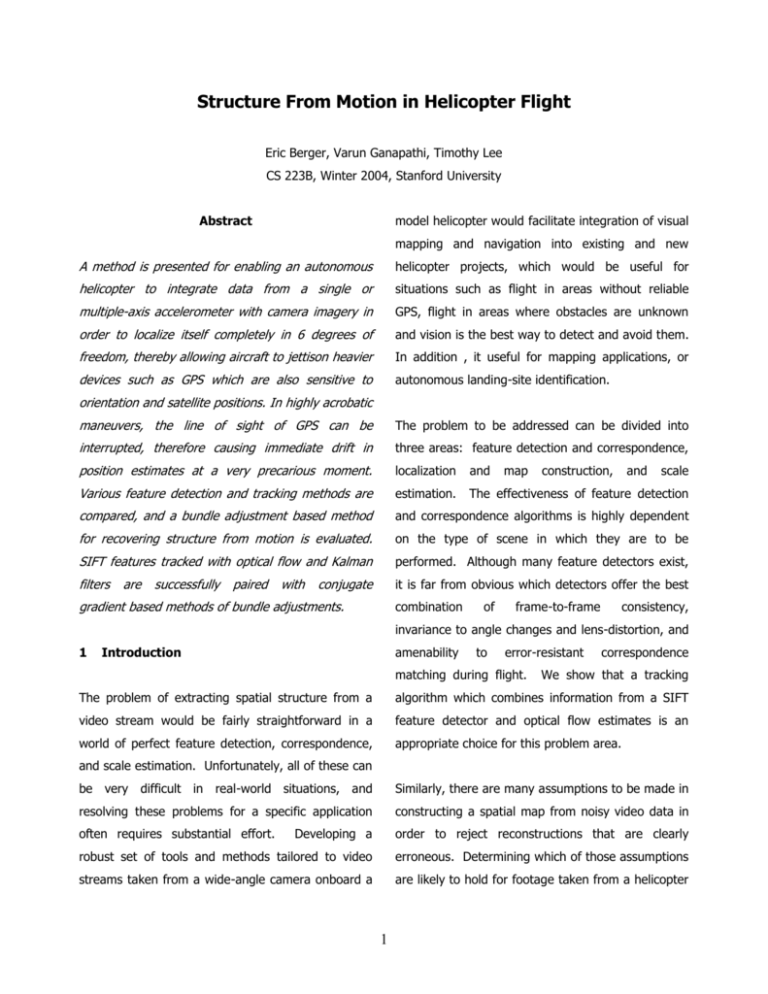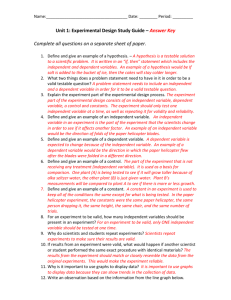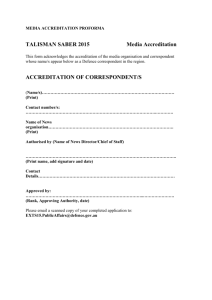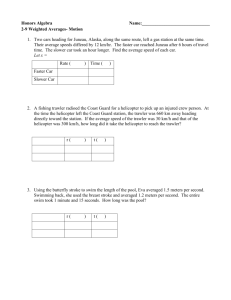submitted - Stanford University
advertisement

Structure From Motion in Helicopter Flight Eric Berger, Varun Ganapathi, Timothy Lee CS 223B, Winter 2004, Stanford University Abstract model helicopter would facilitate integration of visual mapping and navigation into existing and new A method is presented for enabling an autonomous helicopter projects, which would be useful for helicopter to integrate data from a single or situations such as flight in areas without reliable multiple-axis accelerometer with camera imagery in GPS, flight in areas where obstacles are unknown order to localize itself completely in 6 degrees of and vision is the best way to detect and avoid them. freedom, thereby allowing aircraft to jettison heavier In addition , it useful for mapping applications, or devices such as GPS which are also sensitive to autonomous landing-site identification. orientation and satellite positions. In highly acrobatic maneuvers, the line of sight of GPS can be The problem to be addressed can be divided into interrupted, therefore causing immediate drift in three areas: feature detection and correspondence, position estimates at a very precarious moment. localization and Various feature detection and tracking methods are estimation. The effectiveness of feature detection compared, and a bundle adjustment based method and correspondence algorithms is highly dependent for recovering structure from motion is evaluated. on the type of scene in which they are to be SIFT features tracked with optical flow and Kalman performed. Although many feature detectors exist, filters it is far from obvious which detectors offer the best are successfully paired with conjugate gradient based methods of bundle adjustments. combination of map construction, frame-to-frame and scale consistency, invariance to angle changes and lens-distortion, and 1 Introduction amenability to error-resistant matching during flight. correspondence We show that a tracking The problem of extracting spatial structure from a algorithm which combines information from a SIFT video stream would be fairly straightforward in a feature detector and optical flow estimates is an world of perfect feature detection, correspondence, appropriate choice for this problem area. and scale estimation. Unfortunately, all of these can be very difficult in real-world situations, and Similarly, there are many assumptions to be made in resolving these problems for a specific application constructing a spatial map from noisy video data in often requires substantial effort. Developing a order to reject reconstructions that are clearly robust set of tools and methods tailored to video erroneous. Determining which of those assumptions streams taken from a wide-angle camera onboard a are likely to hold for footage taken from a helicopter 1 will make the resulting mapping and localization A combination of existing feature detectors and process more robust and efficient than a general- structure from motion algorithms with heuristics for purpose structure from motion algorithm, since the scale estimation, with a focus on obtaining data types of errors that are most worrisome for the suitable for use in a helicopter control system, purposes are comprises a package which can robustly estimate significantly different from the types of errors that the structure of the environment and the trajectory are a problem for scanning a model in a laboratory. of the camera within it for the types of images and Additionally, the use of a wide-angle lens makes the movement patterns typically seen in helicopter solution of the structure from motion problem under flight. There are significant constraints on the types perspective necessary, which is significantly harder of motion and types of scene that the system needs than in cases where an orthographic projection is a to process which can be leveraged to obtain better good approximation1. Bundle adjustment is one feature correspondence and better initial structure solution to the problem of projective structure from estimates than unconstrained structure from motion. motion; however, because of the size of the In addition, use of a wide-angle lens enables us to minimization problem involved it can be difficult to track individual features and feature patterns over a compute quickly. In order to speed the minimization relatively long distance, in order to ensure that orthographic is different portions of our constructed map will be combined with altitude estimates in order to obtain consistent with one another in terms of translation, accurate initial guesses for helicopter motion and orientation, and scale. reduce of the keeping a helicopter Tomasi-Kanade number of aloft factorization iterations needed for convergence. 2 Finally, the scale estimation problem is one that Although onboard vision is potentially one of the does not have a solution within the framework of most powerful types of sensors for airborne vehicles, traditional structure from motion, although solving it it is still not an easy task to integrate a vision is a key step on the way to the development and processing use of a vision-based navigation system for a platform. helicopter. Identifying clues from either the image small aircraft have been used for applications where stream itself, or from other sensors, that will work in no processing is necessary, specifically for obtaining unstructured outdoors environments is key to pictures and videos and for allowing remote human ensuring the applicability of this method to real- control of the craft. world In used an measurement units for landing assistance 1,2. problems particular, in autonomous integration with aviation. data from Background in system into an existing helicopter The majority of cameras mounted on Vision has been successfully conjunction with GPS and inertial All accelerometer is shown to disambiguate the scale successful landing demonstrations, however, have problem and allow fully accurate 3D reconstruction relied on the use of known landing pads, which of ego-motion and environment structure. reduces the vision-processing component of the 2 problem to a fitting of a known marker geometry to detections combined with optical flow and Kalman an image from a calibrated camera. filters. CMU has developed a “visual odometer” system onboard a helicopter, using custom hardware and stereo 3 Approach cameras, which was used in conjunction with full GPS and IMU measurements to track the helicopter’s Our major areas of focus in this work are feature movement through an environment and construct extraction and 3D reconstruction. models, however their approach was to use stereo decouple these two problems from one another and cameras, special purpose hardware, and all available allow us to optimize each of them independently, we 3 In order to data . To date, no system has been developed for have also tested extensively on synthetic data-sets allowing a helicopter to be flown autonomously and used these to perfect our 3D reconstruction and based mainly on onboard data, or for integrating solution of the scale problem. limited external sensor data to resolve the scale problem automatically. Our overall goal for the algorithm is to use the change in image location of features over time in Feature Detection and Tracking order to estimate location of the points in space and travel of the helicopter. To do this, it is important Since these features will be used for real-time correspondence, they should following qualities: easy ideally to have find, for us to have features which can be observed the consistently uniquely course of significant We would also like to use features which can be to lighting changes. Corner detection is a popular distinguished from one another to make the choice in computer vision and can be classified correspondence problem more robust to large broadly into two categories. The first is based in the motions in image-space between successive update extraction of image contours such as the one steps. described by Tomasi and Kanade7 and another analyzes local gray values.8 There are many other One type of feature that matches these criteria very papers describing different improvements on corner well is intentionally placed visual markers. detection through techniques such as the wavelet Even without prior knowledge of their placement, the transform and various sophisticated edge detection existence of sharp unmistakable corners allows us to algorithms.9,10 Another method finds corners which rely more on the accuracy of our feature detection David algorithm across a wide variety of viewing situations, Lowe also uses the concept of scale space in the and substantially reduces our reliance on specifics of development of an algorithm called SIFT (Scale invariant feature transform).12 the translations and rotations of the helicopter. identifiable, scale and rotation invariant, and robust are highly scale and rotation invariant.11 over the Tracking on a environment in which we are operating. Because a marker provides several different corner sequence of images can be done through feature 3 and edge features, it also allows us to solve the trajectories, which is a much more constrained correspondence problem without relying heavily on space than SIFT features are designed to operate in temporal stability in image space, which is crucial for general. robustness of the algorithm to visual obstructions, emphasizes temporary video-stream loss, or rapid movements of placement, the detected location of SIFT features the helicopter. Ideally, however, our system would over multiple images exhibits some jitter, which is not rely on any type of pre-existing markers, and very undesirable for the later 3D reconstruction could work from observations of its environment. attempt. In addition, however, because SIFT reliable detection over precise Finally, global SIFT detection requires comparison to a global database which grows In order to obtain many of the same advantages of linearly with time, so it cannot be used in the most a marker-based system, we propose using scale obvious way for any system which hopes to be real- invariant feature transforms, or SIFT features, to time, due to the fact that the time required to detect regions of the captured video which will be process each frame scales linearly with the number easy to locate in subsequent frames. of frames processed to date. One of the most important characteristics of the SIFT features is their encoding of the brightness pattern in their A Kalman filter provides a prior over the location and local area, which allows them to be distinguished velocity of a SIFT feature which we are tracking, from one another. This property makes the which allows us to quickly decide whether a given construction of a map large enough that not all SIFT feature has a good match without comparing markers possible, against the global database for every feature, and because it will be possible to recognize features also allows us to track features which are not strong when they are seen again from a combination of enough to be reliably identified by the global sift expected position and expected appearance. SIFT algorithm because the much smaller set of potential features also have the advantage of being relatively matches drastically cuts the potential for false robust to changes in lighting or camera orientation, positive matches. so that we can rely on a given feature being filters effectively, we also integrate the Lucas- available to use for a sufficiently long time that we Kanade pyramidal optical flow algorithm as a means can localize it accurately and use that data to help of estimating image-space feature velocity, so that determine the helicopter’s position and orientation. we would have both position and velocity updates to are in view simultaneously In order to update the Kalman the filter for each tracked point. Although global SIFT correspondence has many advantages for large map generation, for small- After feature detection and correspondence, the displacement tracking it has several disadvantages process of constructing a 3D model of the world and which can be solved by a tracking approach. Most camera trajectory progresses through three main significantly, the algorithm fails to take into account stages. the information that we have about likely helicopter identify features which are tracked the most 4 First, we filter the tracked features to consistently over the segment of video we are each camera, (3 angles and 3 for translation). It is interested in. We identify subsets of frames and important to precondition the solution vectors by features for which all features appear in all frames attributing factors to each component so that they and use these to run orthographic Tomasi-Kanade are close to the same scale. This is especially factorization and achieve initial guesses for relative important when using angles, because each step camera orientations in different segments of video. could cause the cameras to rotate around several Next, align times, if the step size is big relative to the periodicity coordinate axes for the same cameras across of the angle representation. It is preferable to use different factorizations a global estimate of camera angles orientations is constructed, and an assumption that orientation when it is possible to avoid singularities, altitude remains fairly constant over a short timestep because it uses the minimum number of parameters allows full six degree of freedom pose estimates to and automatically satisfies the rotation matrix be obtained for all cameras. constraints. After the initial estimates for camera and 3D-point We used conjugate-gradient descent with pre- positions have been obtained, we begin bundle conditioning to solve the minimization problem. adjustment. Bundle adjustment in general is the Another minimization of re-projection error defined by:14,19 Marquardt-Levenberg with sparse factorization.16 We by using least-squares fitting 2 m P m P Ei , j uij i1 j vij i 2 j mi 3 Pj mi 3 Pj to over very some other popular parameterization minimization method of is advocate no particular minimization method in 2 particular, since hundreds of papers have been written on this topic. where (u,v) are the positions of the features in the It is important to note that scale cannot be image plane, M is the 3 by 4 matrix defining a recovered camera described above. The equation below illustrates the projection, namely a rotation and translation, and P, point defined in 3D homogenous ambiguity t coordinates, that is, (Pw 1) . from of minimizing the free the variable error of function lambda, representing scale. Intuitively, it means that if you M [R T ] change all the position units to a different one, from The goal is to solve for the X,Y,Z coordinates of the centimeters to meters, for example, the error 3D points represented by the features and the 12 function will remain the same.15,19 parameters defining a camera. It is important to pim perform outlier removal, which we performed by P P 1 1 ( RT )( ) ( R T )( ) 1 1 z z capping the maximum error contribution of a feature Finally, when a solution is reached for the bundle in a given image. In our case, the camera was adjustment, the problem of scale is addressed. calibrated, so the calibration constants can be this stage, information from any external scale- factored out, leaving 6 parameters to be solved for 5 In dependent sensor can be used to resolve the magnitude of the acceleration vector given by the ambiguities. vision based and sensor based methods. This has In the case of helicopter flight, one obvious option is an accelerometer. the added benefit of avoiding the problem of 2 2 Tw 2 ( Accw ) 2 t deciding what to do when you find a different scale factor for each component of the vector. 2 T w 2 In this case, a Kalman filter or some method can be used for estimating the second derivative of the t 2 2 ( Accw ) translation vectors of the cameras. Since our images Since both coordinate frames are formed by are recorded at a fixed rate, and we have vision orthonormal basis vectors, it is not necessary know based position estimates at each frame, these how the camera is positioned relative to the arm, derivatives are easy to calculate. In the results since this will not affect the magnitudes of the section, we will describe an experiment in which we vectors even if we transformed them to the same mounted a camera on a robotic arm to get very frame. precise position estimates of the helicopter. This allows us to isolate the error in our experiment After scale is solved it then becomes an other almost exclusively to the method of recovering equally easy problem to solve for the relative structure from motion, because the PUMA robotic orientation between the two frames. In this case, arm has very high precision sensors that are since sampled at 500hz. orthonormality, we use the SVD method described the rotation matrix is constrained by by Trucco and Verri to extract the answer satisfying The scaling of our structure from motion estimate to the constraints from the least squares solution. 2T Rc 2 Rs ( Acc.) t match the data from the accelerometer is the solution of a linear system, where we find the factor which achieves the best match between the acceleration values predicted by a Kalman filter run 4 over the structure from motion solution and those measured directly. 4.1 Results Hardware setup We put together a small monochrome camera with a This can be accomplished even if the orientation of wide-angle lens and an analog transmitter which can the sensors relative to each other is not known to beam the video back to the ground. We used off- high precision, which is a practical problem that board processing with a real-time analog video link occurs in both the case of a helicopter and robotic from the helicopter which minimized the amount of arm. For instance in our case, since gravity does not equipment which actually needed to be in the air for affect the acceleration readings of the PUMA arm, the system to be operational, and kept the flight we can simply solve a linear equation between the setup both cheap and light. 6 The helicopter maintained GPS and IMU information to be used as validation for the results of structure from motion. As an additional method of gathering video data with ground truth position measurements, we mounted the camera on a PUMA robotic arm. Using this setup we were able to gather more controlled datasets of a variety of environments and motion profiles without the overhead incurred by operating the helicopter. 4.2 Figure 2 - Marker correspondence Feature tracking 4.3 We began feature tracking by analyzing images with SIFT with global correspondence known markers, which could potentially be used to One approach to the tracking problem is to find SIFT solve the scale estimation problem. The image was filtered using standard canny edge features for each frame and apply the global detection matching technique described by Lowe to determine techniques with the Hough transform, shown below. correspondence.12 Figure 3 below shows the correspondences marked in green circles between one frame and another one, 40 frames later. Only features that have been tracked through every frame are displayed. It may be difficult to see at this resolution, but the correspondence is fairly good; however, there is still an average error of 2-3 pixels in localizing the feature being tracked. Another disadvantage is this method is increasingly slow as the global database of SIFT features grows. This problem can be alleviated by retiring SIFT Figure 1 – Image filtered with Canny and Hough features from the database that have not been seen in a certain number of frames. The correspondence problem is solved by globally searching the detected features and matching them with the markers through prior knowledge of the marker configuration (4 white boxes arranged in an "L" pattern). Contours were extracted from the edges, and polygons fitted to these contours. Probable marker locations are extracted from the set of polygons and illustrated below with green circles. 7 due to the inaccuracy of the optical flow estimates. Over a period of 40 frames, the tracked features drifted significantly and many were lost completely since the predictions found through optical flow were not accurate enough. In general, only 40 trackable features per frame were discovered as opposed to over 1000 using SIFT. (a) (a) (b) Figure 3 - Matching SIFT through global correspondence. (a) is the first frame, and (b) is 40 frames later. 4.4 Corner detection with optical flow Figure 4 shows the results of a state of the art (b) corner detection implementation paired with Jean Ives Bouguet’s (Intel) pyramidal implementation of Figure 4 - Matching corners through optical flow. the Lucas-Kanade feature tracker.13 (a) is the first frame, and (b) is 40 frames later. First, corners were detected and then optical flow estimates 4.5 generated. The corners detected in the next frame were matched with the position estimates. SIFT with optical flow The execution time for this method was extremely fast, SIFT feature detection paired with the Lucas-Kanade but the corners matched poorly, even between algorithm tracked features accurately over many frames very similar to each other. This was mostly frames. However, many features were lost because, 8 again, the optical flow predictions were not accurate This implementation tracked a large number of enough. Figure 5 below shows the accurate features extremely accurately and would be a very correspondences, but sparse number of tracked robust input to the structure from motion algorithm. features. This method has several advantages over the global matching scheme including speed, superior localization, and robustness in matching, because the similarity between frames is taken into account. (a) (a) (b) Figure 5 - Matching SIFT features through optical flow. (a) is the first frame, and (b) is 40 frames later. (b) Figure 4 - Matching SIFT features through optical 4.6 SIFT with optical flow and Kalman filters flow and Kalman filters. (a) is the first frame, and (b) is 40 frames later. Combining optical flow predictions with Kalman filters proved to be the best solution. After finding 3D Reconstruction: Our bundle adjustment proved SIFT features and estimated velocities using optical to be sufficiently robust to obtain good solutions flow for an image, Kalman filters were created with from our orthographic position estimates in many the positions and velocities as the state variable. different situations. We were unable to collect world 9 truth data from a helicopter due to an operating minimization techniques don’t explicitly take into system crash on the base station that records the account the fact that the angular velocity of the readings from the helicopter’s sensor package, cameras from frame to frame change smoothly. which includes GPS, accelerometers, gyroscopes and After magnetometers. experimental parameterization, it would be possible to include a apparatus for testing the method was a robotic arm term into the error function that is proportional to with very high precision sensors. This set up was the delta between the free angular velocity and the perhaps the predicted angular velocity given a Kalman filter performance of the visual system alone, because prediction combined with a simulator prediction. This ground truth is known to higher precision. By would have the effect of giving consecutive camera mounting the camera on the robotic arm and estimates recording the position estimates according to the robustness to occasional outliers. Perhaps it is arm, and calculating the position estimates of the possible to use a particle filter based system that visual system we developed, we were able to solve simply evolves the motion of many camera and then for the scale factor. We were then able calculate the spawns more particles around areas of lower bundle errors in each component of our 6 degree of error. Therefore, launching the helicopter from a freedom measurement, shown below. known environment thereby initializing it with good a Instead, better choice our for evaluating changing a to an “momentum” angular thereby velocity improving estimates might allow much better results in the 5 Future Work predictions returned by the visual system. Given a situation with known feature positions, this would be Our work was limited by the availability of the easy to implement; assimilating helicopter and the short duration of the academic gracefully into the estimates might be more difficult. quarter. possible On another side, there is the closing-the-circle improvements to the design that we unfortunately problem of feature tracking where a camera that didn’t get a chance to implement. Among these are rotates in a circle should pick up correspondences developing a method of integrating new data into between features seen before and features currently previous estimates of structure rather than simply in view. solving over a given window of images. In addition, having to do a lookup in a global database every an interesting bundle time would be to shoot a ray through a current adjustment problem could use angular velocities feature and see how many predicted 3D feature instead of Euler angles for orientation information. points it intersects and comparing the given feature In conjunction with integrating new estimates into with each of those. Using a KD-Tree structure, past estimates, we are looking into ways of using a shooting the ray would be a fast operation and limit estimates of position and velocity from a helicopter the number of sift feature comparisons required. simulator to narrow down the search space for the After deciding that a feature is in fact identical to an bundle old feature, combine them and perform future We had many ideas of parameterization of the adjustment problem. Currently, the 10 new features A method for performing this without bundle adjustments using their combined such as an accelerometer to resolve the uncertainty information. Finally, the use of aerial maps presents about scale which structure from motion cannot many opportunities for improving the quality of the resolve. This represents substantial steps in the results from an onboard camera. direction of allowing autonomous flight of a helicopter without GPS, and demonstrates that 6 Summary and Conclusion projective structure from motion can be done effectively as a method of localization for a We have developed a system which allows us to helicopter. Vision-based methods cannot completely take a video stream typical of that which could be eliminate the need for other sensors because of easily obtained from a helicopter without heavy or scale ambiguity, but they can work in conjunction to expensive find act as a surrogate for GPS and therefore correct estimated for ego-motion and world structure. positional drift caused by integrating predictions Additionally, we provide a framework for matching from transmission equipment and camera data with a external scale-sensitive sensor 11 other sensors. 7 References [1] C. Sharp, O. Shakernia, and S. Sastry, “A vision system for landing an unmanned aerial vehicle,” in In Proceedings of IEEE International Conference on Robotics and Automation, 2001, pp. 1720-1728. [2] S. Saripalli, J. F. Montgomery, and G. S. Sukhatme, “Visionbased autonomous landing of an unmanned aerial vehicle,” in IEEE International Conference on Robotics and Automation,Washington D.C., May 2002, pp. 2799–2804. [3] O. Amidi, T. Kanade, and R. Miller. Vision-based autonomous helicopter research at cmu. In Proceedings of Heli Japan 98, Gifu, Japan, 1998. [4] J. Oliensis, "A Multi--frame Structure from Motion Algorithm under perspective Projection," NECI TR April 1997 [5] J. Weng, T.S. Huang, and N. Ahuja. Motion and structure from two perspective views: algorithms, error analysis and error estimation. IEEE Transactions on Pattern Analysis and Machine Intelligence, 11(5):451--476, 1989. [6] S. Se, D. Lowe, and J. Little. Global Localization using Distinctive Visual Features, Proceedings of the 2002 IEEE/RSJ Intl. Conference on Intelligent Robots and Systems EPFL, Lausanne, Switzerland, October 2002 [7] C. Tomasi and T. Kanade, Shape and Motion from Image Streams: a Factorization Method-3.Detection and Tracking of Point Features, Technical Report CMU-CS-91-132, Carnegie Mellon University, Pittsburgh (PA) 1991. [8] Xu Zhang, Detection of moving corners in dynamic images. Industrial Electronics, 1994. Symposium Proceedings, ISIE ’94., 1994 IEEE International Symposium, 25-27 May 1994. Pages 36-41. [9] Lee, J.S.; Sun, Y.N.; Chen, C.H. Wavelet transform for corner detection. Systems Engineering, 1992, IEEE International Conference, Volume: 2, 17-19 Sept. 1992. Pages 596599. [10] Etou, Y.; Sugiyama, T.; Abe, K.; Abe, T. Corner detection using slit rotational edgefeature detector. Image Processing, 2002. Proceedings. 2002 International Conference. Volume: 2, 22-25 Sept. 2002. Pages II-797 – II-800 vol. 2. [11] Ying Cui; Lawrence, P.D. Detecting scale-space consistent corners based on corner attributes. Systems, Man and Cybernetics, 1995. ‘Intelligent Systems for the 21st Century’. IEEE International Conference, Volume: 4, 22-25 Oct. 1995. Pages 3549-3554. 12 [12] Lowe, D.G. Object recognition from local scale-invariant features. Computer Vision, 1999. The Proceedings of the Seventh IEEE International Conference. Volume: 2, 20-27, Sept. 1999. Pages 1150-1157. [13] B.D. Lucas and ZT. Kanade, An Iterative Image Registration Technique with an Application to Stereo Vision, Proc. 7th International Joint Conference on Artificial Intelligence, Vancouver (CA), pp. 647-679 (1981). [14]S. Mahamud, M. Herbert, Y. Omori, and J. Ponce. Provably-convergent iterative methods for projective structure and motion. In Proceedings of the Conference on Computer Vision and Pattern Recognition, Kauai, Hawaii, USA. IEEE Computer Society Press, December 2001. [15]Istituto Elettrotecnico Nazionale. Robust 3D Reconstruction for Autonomous Manipulation - Geometry/Structure Estimation. World Wide Web Publication, http://www.ien.it/is/rec3d/structure.html. Accessed 2004. [16]N.A.Thacker and T.F.Cootes. Vision Through Optimization. World Wide Web Publication, http://www.dai.ed.ac.uk/CVonline/LOCAL_COPIES/BMVA96Tut/node23.html. Accessed 2004. [17]Pollefeys, Marc. Visual 3D Modeling from Images. World Wide Web Publication, http://www.cs.unc.edu/~marc/tutorial/node159.html. Accessed 2004. [18]Dellaert, Frank. Bundle Adjustment. World Wide Web Publication, http://www.cc.gatech.edu/classes/AY2003/cs8803d_fall/sparse.pdf. Accessed 2004. [19] Forsyth and Ponce, Computer Vision – A Modern Approach. Chapter 13. Prentice Hall, 2003 13





